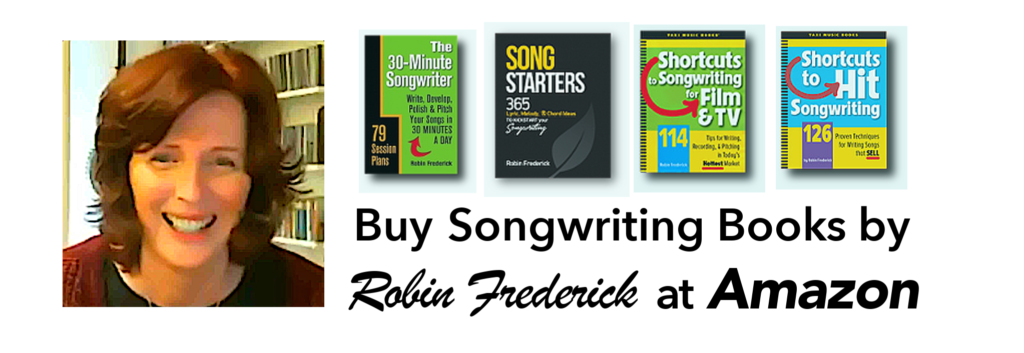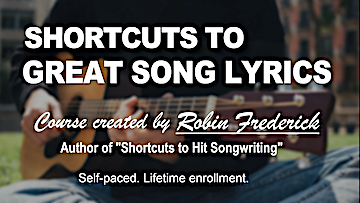Q: I want to learn more about what kind of music is current. Where do you find new music and artists to listen to? Also I want to pitch my songs to film & TV. Where can I hear artists that are being used in that market?
A: If you’ve been getting my monthly emails, you know that I’m big on listening. I recommend that songwriters spend as much time listening as they spend writing. That means listening to successful songs, current songs, songs that inspire you as often as you can.
But there’s a huge amount of music out there—more every week, every day— so much that it can seem overwhelming. So, how do you find new music and artists to listen to? How do you know where to look and how to focus on what will be helpful to you as a songwriter? Here’s my guide to finding new music that will deliver plenty of inspiration, knowledge, and ideas for your own songs.
KNOW WHAT YOU’RE LOOKING FOR
✓ Songs that turn your songwriting switch “on”
Listening to songs you like—familiar songs, new songs, old songs—will help you turn on the “songwriting switch” in your brain. It will get your body feeling rhythm, your brain into rhyming mode, and activate your music/emotion response. It gets you ready to write.
✓ Useful reference songs
Successful songs can guide you toward writing your own songs in that style. You’ll get a feel for lyric language, melody motion, chord progressions, and production. In addition, when a music publisher or Film & TV music supervisor asks who you sound like or what genre you’re in, you’ll be ready with a couple of song titles and artist names.
✓ Songs that listeners like
No matter what business you’re in, if you’re serious about becoming successful, you need to know what your customers like. Want to design an athletic shoe that a lot of people will buy? You’d probably start by studying what Nike and Adidas are doing. The music business is not all that different. Your listeners are your customers. You need to give them something they like. You don’t need to copy (and you shouldn’t), but you do need to know what will appeal to them. Then design your music in a way that will work for them and for you.
HUNT FOR BURIED TREASURE
When I’m looking for songs to analyze in my Hit Song Guides or trying to help a songwriter find reference songs, I’ll spend time going through all of my resources.
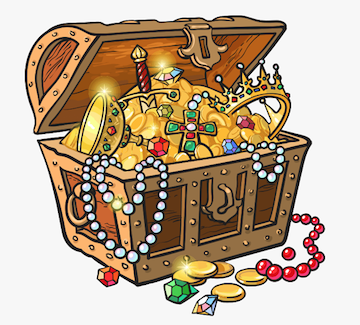
Sometimes I find the perfect song right away; other times it takes hours of searching and listening. A long search can be frustrating, but along the way I almost always trip over some radiant little Singer-Songwriter gem or overlooked Pop/Rock epic that takes my breath away. Just like unearthing buried treasure—you gotta dig a lot of holes before you hit pay dirt.
So, let’s go on a treasure hunt for recent songs you might like. To do that, you need an easy-to-use resource where you can listen to and study songs in the styles you want to write in.
Make one of these your go-to resource…
Use stream-on-demand music playlists
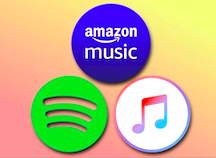
SPOTIFY – APPLE MUSIC – AMAZON MUSIC UNLIMITED
If you’re serious about songwriting, you need to have a subscription to a good stream-on-demand service. It will cost around $10 to $12 per month and it’s well worth it. All three of these sites have millions of songs and hundreds of curated playlists sorted in a variety of ways.
Start by searching for playlists in a genre you’re interested in. Type the name of the genre in the Search box or choose from the listed genres—Pop, Folk, Singer-Songwriter, Rock, Country, R&B/Soul, and so on. Here’s a screen grab of what you get when you click on the Search box in Amazon Music Unlimited.
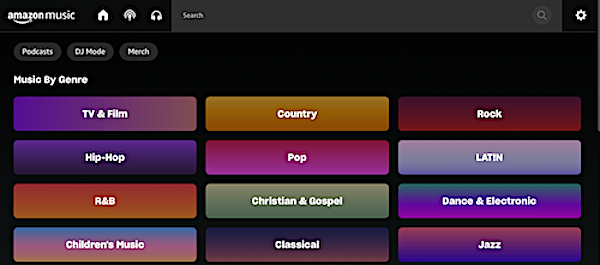
The mainstream genres like Pop and Country are there plus many more. Or search for a current artist you like and find playlists that include them. Then go through the songs in those playlists. When you find a song or artist you’re interested in start a playlist of your own using that song or several songs by that artist.
REMINDER: Don’t waste time on songs you don’t like. Keep moving.
LET THEM DO THE WORK!
Each of these sites creates a weekly playlist that uses your listening history to find songs that are similar, providing an easy way to discover more music that’s likely to appeal to you. The problem is you have to have a listening history before they can create one of those. If you’ve started a couple playlists as I described above then you’re all set to go. Look for the following customized playlists.
SPOTIFY – “Discover Weekly”
APPLE MUSIC – “New Music Mix”
AMAZON MUSIC UNLIMITED – “My Discover Mix”
Here’s a good Spotify trick
Spotify is generally considered to be better than other stream-on-demand music sites at finding new songs you will like. It’s also the one I use so I’m more familiar with it than the other streaming services, but I’m sure all of them have something similar to this.
When listening to songs in different genres or moods, keep them in separate playlists. Don’t mix them together. Once you’ve created a playlist of songs with a similar vibe, Spotify will offer more suggestions at the bottom of the list. Listen to those and click the “Add” button when you hear something that’s a good fit. The song will move up to your playlist. Click “Refresh” to get rid of the songs you don’t want and get a new batch of suggestions.
TIP: Give your playlists titles that will help you identify them, either the name of the genre (Alt Country, Pop R&B, Rock, Indie Folk, etc.) or a descriptive title like “Uptempo Happy” or Sad and Slow.”
Use radio-style services

PANDORA – NAPSTER
Pandora (in the U.S.) and Napster (Europe, Latin America, Japan etc.) function like regular radio stations. You can’t choose to listen to a specific song, but they will start a “station” for you with a single song or artist of your choice and populate that station with songs that have a similar sound and style. You can start new stations, save a station, come back later and they will add more songs.
Generate a list of similar songs
Once you’ve turned up one or two songs you like, here’s a great way to find a bunch more songs and artists in that style.
On SpotAlike.com enter a song title in the search box and they will generate a list of 30 to 40 songs that their algorithm identifies as being similar. It’s a great way to quickly scroll through and discover new artists and songs.
NOTE: If you input a song that’s too obscure, they won’t have matches for it. But they do have all mainstream hits and they’re adding more of the popular streaming songs daily. If you don’t get a result, try another similar song.
TV shows and Tunefind
There are dozens of television series that use songs, many of them by new and emerging artists. If you have the Shazam app on your phone, you can often identify songs while they are playing in a scene or commercial, but you’ve gotta be quick! What if you miss it? And who has time to watch a lot of TV anyway?
You can find out what songs are being played without watching endless hours of shows just by going to Tunefind.com.
Search by the name of the show to bring up all seasons and all episodes along with lists of songs that were used. You’ll often be able to audition a 30-second excerpt of the song right there to see if it interests you.
Music Blogs
Music blogs are a great place to find new music and artists to listen to. There are a lot of music blogs out there. A quick check of the Internet will turn up plenty to choose from. Check them out to see which ones are useful for you. Here’s a good list of music blogs. Find a blog that regularly suggests songs and artists you like and then check back often.
Music Charts
When Billboard Magazine started charging for access to its music charts and Nielsen sold off their free online radio charts (BDSradio), it was hard to find a list of current radio hits. Even though streaming has overtaken radio, I still want to see what radio is playing because I can be pretty sure that listeners like those songs. (Radio can’t afford to play songs that listeners will tune out. ) I finally found the iHeart Radio music charts online. These cover all the standard mainstream formats—Country, Rock, Top 40, etc. and they’re up-to-date. I especially rely on the Triple A chart for current singer songwriters, indie Pop, and Americana. You can also find charts for non-mainstream genres like Folk be searching online.
Music libraries
Music libraries are actually a great place to hear what film and TV shows are looking for (which means what music supervisors are looking for). For ideas on the kinds of instrumental cues or songs that sync libraries look for, visit any online library like Crucial Music or 5 Alarm Music. Use their Search function to find out what they have in their catalog, how they identify and sort tracks, and identify what they don’t have. (Maybe you’ve got something they need!) This is a great exercise in itself. Where would your tracks fit? Listen to songs in a style you write in or something you’d like to aim for.
These libraries generally accept online submissions, but be sure you do your research first.
LISTEN WITH SONGWRITER EARS

So, what are you waiting for? Go find some new songs to listen to. Spend at least an hour twice a week listening to new music and artists. Immerse yourself in it before you write. You’ll discover new ideas and ways to solve problems while giving your songs a more current edge.
Don’t be a passive listener. Print out the lyrics and play the song as you read along. How did the lyric get you engaged and interested? Sing or hum along to find out how the melody feels. Listen to the rhythm of the melody and how it fits the lyric. Ask yourself what you like about the songs. Or what you don’t like.
READ MORE TIPS on my website to help you listen like a songwriter.
Of course, the heart of your music will always be YOU, but sometimes a small change in the way the chorus wraps up or the melody in the verse can make a big difference in whether the song finds a home in today’s music market.

